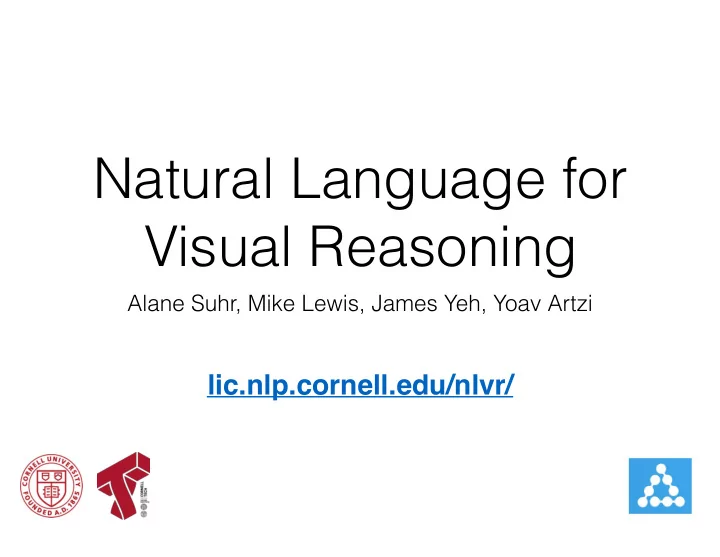

Natural Language for Visual Reasoning Alane Suhr, Mike Lewis, James Yeh, Yoav Artzi lic.nlp.cornell.edu/nlvr/
Language and Vision A small herd of cows in a large What is the dog carrying? grassy field. (Agrawal et al 2015) (Chen et al 2015) Our goal: natural language with a diverse set of semantic and syntactic phenomenon
Natural Language for Visual Reasoning There is a box with 3 items of all 3 different colors. TRUE Task: determine whether the statement is true or false for the image.
Outline • Task and environments • Data collection • Analysis • Baselines
Task and Environments Scatter There is a box with 3 items of all 3 different colors. TRUE Tower There are only two towers which has the same base color. FALSE
Data collection • Goal: collect natural language descriptions of images and true/false judgments • Generate images • Collect natural language sentences • Validate image/sentence pairs
Image Generation
Image Generation • Randomly choose number of items per box and item shapes, colors, sizes, and positions (without overlap)
Image Generation • Randomly choose number of items per box and item shapes, colors, sizes, and positions (without overlap) • Construct second image with the same type
Image Generation • Randomly choose number of items per box and item shapes, colors, sizes, and positions (without overlap) • Construct second image with the same type
Image Generation • Randomly choose number of items per box and item shapes, colors, sizes, and positions (without overlap) • Construct second image with the same type • Construct third image by shuffling items in the first image
Image Generation • Randomly choose number of items per box and item shapes, colors, sizes, and positions (without overlap) • Construct second image with the same type • Construct third image by shuffling items in the first image
Image Generation • Randomly choose number of items per box and item shapes, colors, sizes, and positions (without overlap) • Construct second image with the same type • Construct third image by shuffling items in the first image • Construct fourth image by shuffling items in the second image Generate two unique images and permute their items to create two other images
Sentence Writing Write a sentence that is true about the top two images and false about the bottom two. • Don’t refer to the order of the images. • Don’t refer to the order of the boxes. There is a box with 3 items There is a box with 3 items There is a box with 3 items There is a box with 3 items of all 3 different colors. of all 3 different colors. of all 3 different colors. of all 3 different colors. Setup encourages set reasoning, counting, and comparisons
Sentence Writing There is a box with 3 items of all 3 different colors. TRUE There is a box with 3 items of all 3 different colors. TRUE There is a box with 3 items of all 3 different colors. FALSE There is a box with 3 items of all 3 different colors. FALSE
Validation There is a box with 3 items of all 3 different colors. • Higher-quality data • Measure agreement • Make sure sentences follow the guidelines Fleiss’ κ : 0.709 ➡ 0.808
Validation There is a box with 3 items of all 3 different colors. ☐ TRUE ☑︎ FALSE
Permutation ☐ TRUE There is a box with 3 items of all 3 different colors. ☑︎ FALSE
Corpus Statistics • 92,244 examples • Four data splits • 80.7% training • 3,962 unique sentences • 6.4% development • Krippendorff’s α : 0.831 • 6.4% public test • Fleiss’ κ : 0.808 • (Landis and Koch, 1977) • 6.4% unreleased test • 262 words in the vocabulary • Average sentence length of 11.2 lic.nlp.cornell.edu/nlvr
Related Corpora Task Examples A small herd of Caption MSCOCO cows in a large generation (Chen et al 2015) grassy field. How many objects are Question CLEVR either small cylinders answering or red things? (Johnson et al 2016) What is the dog Question VQA — real carrying? answering (Agrawal et al 2015) Question Is this a forest? VQA — abstract answering (Agrawal et al 2015) there are exactly three Binary NLVR blue objects not classification (Suhr et al 2017) touching any edge
Related Corpora Natural Task Real images? language? ✔ ✔ Caption MSCOCO generation (Chen et al 2015) ✗ ✗ Question CLEVR answering (Johnson et al 2016) ✔ ✔ Question VQA — real answering (Agrawal et al 2015) ✗ ✔ Question VQA — abstract answering (Agrawal et al 2015) ✗ ✔ Binary NLVR classification (Suhr et al 2017)
Lengths VQA real images VQA abstract images NLVR (ours) MSCOCO CLEVR 30 24 18 12 6 0 1 6 11 16 21 26 31 36 41 Longer than VQA Similar to MS COCO
Linguistic Analysis Analyzed 200 random development sentences. VQA (abstract) VQA (real) NLVR Soft cardinality Hard cardinality Coordination Negation Existential Universal quantifiers quantifiers Coreference Presupposition Prepositional Coordination ambiguity Comparisons ambiguity Spatial relations
Numerical Expressions Hard cardinality 66% 12% 12% There is a tower with exactly three blocks, and it has a yellow block and two blue blocks. TRUE Soft cardinality 16% 1% 0% there are at least two yellow VQA (abstract) squares not touching any edge VQA (real) NLVR TRUE
Negation and Coordination Negation 10% 1% 0% There is a box with a black item between 2 items of the same color and no item on top of that. TRUE Coordination 17% 5% 3% There is a box with a yellow item and VQA (abstract) VQA (real) three black items. NLVR TRUE
Baselines Accuracy on unreleased test set 62.0 56.3 56.2 55.4 55.3 Majority class Text Image CNN+RNN NMN only only (Andreas et al 2015) (RNN) (CNN)
Feature-based Analysis • Features text and structured representation • Use maximum entropy model Accuracy 68.04 67.82 57.7 Unreleased test Dev No count features
http://lic.nlp.cornell.edu/nlvr/ Thank you!
Recommend
More recommend